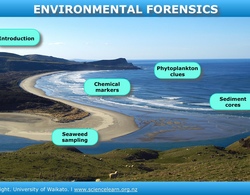Transcript
Dr Candida Savage
We don't have the luxury of having data that goes back 100 years or more, and we don't often have the data that goes back 10 years, so we try and reconstruct the situation that was present using what I call environmental forensics, so basically trying to use records that are preserved in sediments. It’s the same idea as using tree rings on land and also using the ice records down in the Antarctic. So we’ll take a core that’s about a metre long, which we take from the boat, and then we basically section that core down the middle and we sample through time. And basically over time, naturally the phytoplankton have been settling down to the sea bed and being preserved there. And so what we can do is section back through time, and we can try and reconstruct changes in that phytoplankton over a 100-year or 200-year time period. And some phytoplankton are preserved whole. Those that dissolve basically and disintegrate, they leave behind chemical markers that will tell us which groups of phytoplankton were there in the water column previously.
Video: University of Waikato


